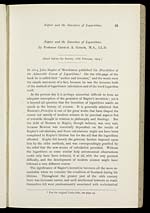John Napier (1550-1617)
Napier and the invention of logarithms
Napier and the Invention of Logarithms.
35
Napier and the Invention of Logarithms.
By Professor GEORGE A. GIBSON, M.A., LL.D.
[Read before the Society, 11th February, 1914.]
IN 1614 John Napier of Merchiston published his Description of
the Admirable Canon of Logarithms.1 On the title-page of the
book he is called their “author and inventor,” and the words were
the simple statement of a fact, because he was the inventor both
of the method of logarithmic calculation and of the word logarithm
itself.
At the present day it is perhaps somewhat difficult to form an
adequate conception of the greatness of Napier's invention; yet it
is beyond all question that the invention of logarithms marks an
epoch in the history of science. It is generally admitted that
Newton's Principia is one of the great works that have shaped the
course not merely of modern science in its practical aspects but
of scientific thought in relation to philosophy and theology. But
the debt of Newton to Napier, though indirect, was very real,
because Newton was essentially dependent on the results of
Kepler's calculations, and these calculations might not have been
completed in Kepler's lifetime but for the aid that the logarithms
afforded. Kepler felt keenly the grievous burden imposed upon
him by the older methods, and was correspondingly gratified by
the relief that the new means of calculation provided. Without
the logarithms or some similar help astronomical observations
could only have been reduced, if at all, with the very greatest
difficulty, and the development of modern science might have
followed a very different course.
The significance of Napier's invention becomes all the more re-
markable when we consider the condition of Scotland during his
lifetime. Throughout the greater part of the 16th century
there was incessant unrest, and such intellectual interests as made
themselves felt were predominantly associated with ecclesiastical
_____________________________________________
1 For the original Latin title, see page 45.


